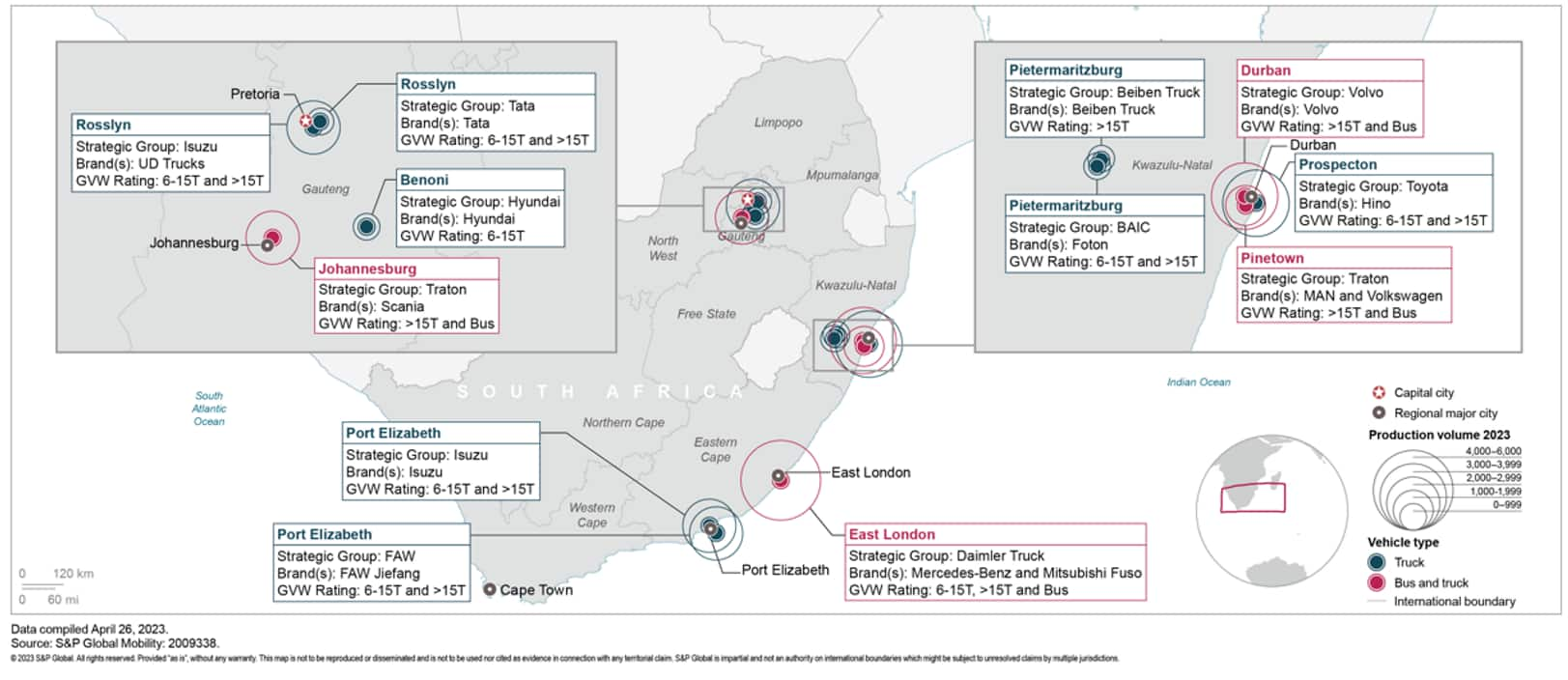Discover more about S&P Global's offerings
Customer Logins
Obtain the data you need to make the most informed decisions by accessing our extensive portfolio of information, analytics, and expertise. Sign in to the product or service center of your choice.
Customer Logins
BLOG
Jun 08, 2023
South Africa’s truck assembler position will be challenged over the decade
The medium and heavy commercial vehicle market in South Africa (gross vehicle weight [GVW] >6 metric tons) is still resilient in the face of ongoing supply chain constraints, an inconducive macroeconomic environment and structural challenges that have extended into 2023. According to S&P Global Mobility forecasts, South African-assembled trucks contributed more than 24,000 units to continental production in 2022, a gain of 15% year over year from 2021 and enough to rank the country among the top 20 medium and heavy commercial vehicle assemblers globally.
Despite 2022's performance, South Africa cannot rest on its laurels. The African Continental Free Trade Area agreement, consisting of 54 African countries including South Africa, is anticipated to attract local truck assembly in other African countries. South Africa needs to urgently solve its internal structural problems to maintain its position; otherwise, countries in the continent will profit from its weakness and take over current projected truck volumes. Aided by favorable automotive policies and regulations in various African countries, European and Asian truck original equipment manufacturers might refocus their assembly plans toward Egypt and Kenya.
With measures being taken to establish a single and tariff-free market, unified "rules of origin" for the automotive industry are being finalized. Key sectors identified due to their capacity to meet local production demand include the automotive industry and the transportation and logistics sectors. As trade between African countries expands, these developments will be beneficial for the continent's truck assembly industry, especially as most intra-African exports are transported by road freight transportation.
It is further anticipated that the free trade agreement will increase commercial road freight transportation. The World Economic Forum is already expecting that this will result in annual demand of close to 2 million trucks by 2023. This would generate potential opportunities for truck OEMs to expand completely knocked down assembly and expand operations to other African countries, for example, Ghana.
During the pandemic, sales and assembly in South Africa were very low. This has now led to pent-up demand from the pandemic years, or unmet demand, in the transportation sector today. As a result, the outlook for truck assembly remains favorable, at least for the short term. This is occurring during persistent low economic growth, electricity shortages, rising interest rates and high fuel prices.
S&P Global Mobility analysts anticipate that the top three truck OEMs — Isuzu, Daimler Truck and Traton — will assemble more than 4,000 units each in 2023 and that in total, more than 25,000 trucks will be assembled in the country. The main assembly hubs in South Africa are located in Eastern Cape, Gauteng and Kwazulu-Natal.

On the African continent, next in line in truck assembly are Egypt and Kenya. Egypt will likely keep its annual production below 5,000 trucks in 2023. The Kenyan government, however, approved regulations limiting the import of used vehicles in 2022, thus limiting substitutes, in some cases, for new locally assembled vehicles. On top of the current forecast volume (4,000 to 5,000 trucks), the Kenyan government plans to increase locally assembled trucks to more than 10,000 units annually. This volume is for export within the free trade area and not just dedicated for local Kenyan demand.
In addition to South Africa, Egypt and Kenya, S&P Global Mobility offers insights and forecasts for a few other African countries. These include Algeria and Nigeria.
Based on the S&P Global Mobility Medium & Heavy Commercial Vehicle Forecast for Middle East/Africa, there is no expected dynamic shift from the current trend for truck assembly in South Africa. The improvement of supply chains and ongoing replacement of older trucks will continue to play a crucial role in supporting the truck assembly industry, to a greater extent as the country addresses its industrial structural challenges. However, ongoing market conditions originating from persistent electricity supply shortages, rising interest rates and low growth could restrain this. Still, S&P Global Mobility analysts expect the industry to continue with its growth trajectory over the remaining forecast period, reaching up to 33,000 units in 2030.
This article was published by S&P Global Mobility and not by S&P Global Ratings, which is a separately managed division of S&P Global.
{"items" : [
{"name":"share","enabled":true,"desc":"<strong>Share</strong>","mobdesc":"Share","options":[ {"name":"facebook","url":"https://www.facebook.com/sharer.php?u=http%3a%2f%2fstage.www.spglobal.com%2fmobility%2fen%2fresearch-analysis%2fsouth-africas-truck-assembler-position-will-be-challenged-over.html","enabled":true},{"name":"twitter","url":"https://twitter.com/intent/tweet?url=http%3a%2f%2fstage.www.spglobal.com%2fmobility%2fen%2fresearch-analysis%2fsouth-africas-truck-assembler-position-will-be-challenged-over.html&text=South+Africa%e2%80%99s+truck+assembler+position+will+be+challenged+over+the+decade+%7c+S%26P+Global+","enabled":true},{"name":"linkedin","url":"https://www.linkedin.com/sharing/share-offsite/?url=http%3a%2f%2fstage.www.spglobal.com%2fmobility%2fen%2fresearch-analysis%2fsouth-africas-truck-assembler-position-will-be-challenged-over.html","enabled":true},{"name":"email","url":"?subject=South Africa’s truck assembler position will be challenged over the decade | S&P Global &body=http%3a%2f%2fstage.www.spglobal.com%2fmobility%2fen%2fresearch-analysis%2fsouth-africas-truck-assembler-position-will-be-challenged-over.html","enabled":true},{"name":"whatsapp","url":"https://api.whatsapp.com/send?text=South+Africa%e2%80%99s+truck+assembler+position+will+be+challenged+over+the+decade+%7c+S%26P+Global+ http%3a%2f%2fstage.www.spglobal.com%2fmobility%2fen%2fresearch-analysis%2fsouth-africas-truck-assembler-position-will-be-challenged-over.html","enabled":true}]}, {"name":"rtt","enabled":true,"mobdesc":"Top"}
]}


